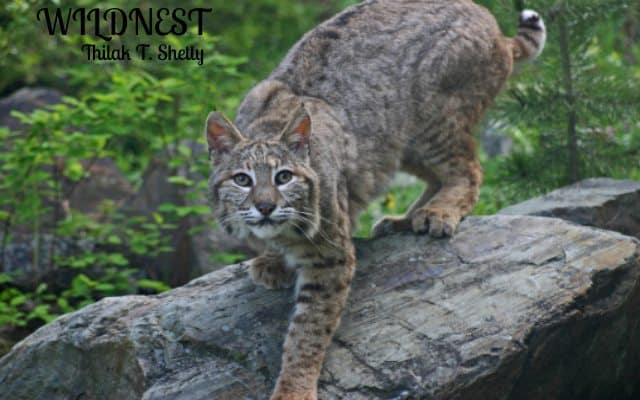Bobcat, also known as the red lynx, is a medium-sized cat native to North America. It ranges from southern Canada through most of the contiguous United States to Oaxaca in Mexico. Two subspecies are recognised: one east of the Great Plains, and the other west of the Great Plains.
It has distinctive black bars on its forelegs and a black-tipped, stubby (or “bobbed”) tail, from which it derives its name. It reaches a total length of up to 125 cm. Its fur, stiffer and less valuable than that of the lynx, is pale brown to reddish with black spots. The underparts are white; the tip of the tail is black above, and white below. The bobcat resembles other species of the midsize genus Lynx but is on average the smallest of the four. Its coat is variable, though generally tan to greyish-brown, with black streaks on the body and dark bars on the forelegs and tail. Its spotted patterning acts as camouflage. The ears are black-tipped and pointed, with short, black tufts. Generally, an off-white colour is seen on the lips, chin, and underparts.
The face appears wide due to ruffs of extended hair beneath the ears. Bobcat’s eyes are yellow with round, black pupils. The nose of the bobcat is pinkish-red, and it has a base colour of grey or yellowish- or brownish-red on its face, sides, and back. The pupils widen during nocturnal activity to maximise light reception. The bobcat has sharp hearing and vision, and a good sense of smell. It is an excellent climber and swims when it needs to, but normally avoids water.
The bobcat is an adaptable species. It prefers woodlands—deciduous, coniferous, or mixed—but does not depend exclusively on the deep forest. It ranges from the humid swamps of Florida to the desert lands of Texas or rugged mountain areas. It makes its home near agricultural areas, if rocky ledges, swamps, or forested tracts are present; its spotted coat serves as camouflage.
The population of the bobcat depends primarily on the population of its prey; other principal factors in the selection of habitat type include protection from severe weather, availability of resting and den sites, dense cover for hunting and escape, and freedom from disturbance.
The bobcat is crepuscular and is active mostly during twilight. It keeps on the move from three hours before sunset until about midnight, and then again from before dawn until three hours after sunrise. Each night, it moves from 3 to 11 km along its habitual route. This behaviour may vary seasonally. Bobcat activities are confined to well-defined territories, which vary in size depending on the sex and the distribution of prey. The home range is marked with faeces, urine scents, and clawing prominent trees in the area. In its territory, the bobcat has numerous places of shelter, usually a main den, and several auxiliary shelters on the outer extent of its range, such as hollow logs, brush piles, thickets, or under rock ledges. Its den smells strongly of the bobcat. The sizes of bobcats’ home ranges vary significantly and range from 0.596–326 km. One study in Kansas found resident males to have ranges of roughly 21 km2, and females less than half that area. Transient bobcats were found to have home ranges of 57 km2 and less well-defined home ranges. Kittens had the smallest range at about 8 km2. Dispersal from the natal range is most pronounced in males.
The bobcat can survive for long periods without food but eats heavily when prey is abundant. During lean periods, it often preys on larger animals, which it can kill and return to feed on later. The bobcat hunts by stalking its prey and then ambushing with a short chase or pounce.
The average lifespan of the bobcat is seven years but rarely exceeds 10 years. The oldest wild bobcat on record was 16 years old, and the oldest captive bobcat lived to be 32. Bobcats generally begin breeding by their second summer, though females may start as early as their first year. Sperm production begins each year by September or October, and the male is fertile into the summer. A dominant male travels with a female and mates with her several times, generally from winter until early spring; this varies by location, but most mating takes place during February and March. The pair may undertake several behaviours, including bumping, chasing, and ambushing. Other males may be in attendance but remain uninvolved.
Once the male recognises the female is receptive, he grasps her in the typical felid neck grip and mates with her. The female may later go on to mate with other males, and males generally mate with several females. The female raises the young alone. One to six, but usually two to four, kittens are born in April or May, after roughly 60 to 70 days of gestation.
Sometimes, a second litter is born as late as September. The female generally gives birth in an enclosed space, usually a small cave or hollow log.
Stories featuring the bobcat, in many variations, are found in some Indigenous cultures of North America, with parallels in South America.
A story from the Nez Perce, for instance, depicts the bobcat and coyote as opposed, to antithetical beings.
In a Shawnee tale, the bobcat is outwitted by a rabbit, which gives rise to its spots. The bobcat is persuaded to build a fire after capturing the rabbit in a tree, only to have the embers fall on its fur, scorching it and leaving it with dark brown spots.
The Mohave people believed dreaming habitually of beings or objects would afford them their characteristics as supernatural powers.

















